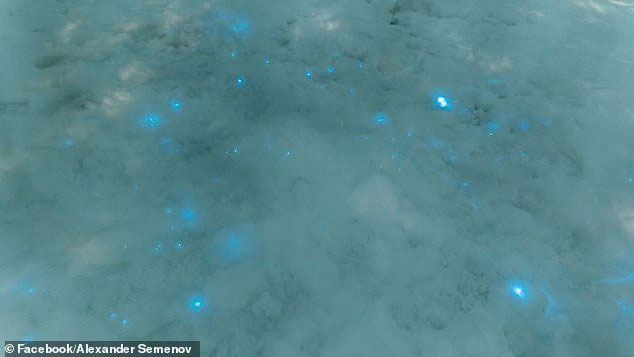A faint blue light appeared on the white snow in a rare event that has not occurred in Russia for 80 years.
During the last days of December, homes and storefronts were aglow with colorful lights in preparation for Christmas and the New Year.
However, in remote areas of Russia, biologists unexpectedly discovered rare sparkling lights standing out against the white snow.
Vera Emelianenko, who made the discovery while walking in the snow, said: “They looked like green Christmas lights in the snow.” She bent down to scoop up a handful of snow, giving a light squeeze, and the “snowball” glowed even brighter.

This beautiful blue light actually comes from tiny bioluminescent animals.
Upon returning, Vera Emelianenko, a microbiologist at a field station, collected samples and placed them under a microscope, discovering that the beautiful blue light was produced by tiny bioluminescent animals.
Copepods are minuscule crustaceans measuring only a few millimeters, comparable in size to a few grains of sand lined up next to each other.
These are some species of arthropods, commonly known as sea lice, which usually inhabit depths of up to 91 meters below the ocean surface. During the day, they operate at great depths but at night, they appear just a few meters from the water’s surface. They wash ashore, caught in the snow due to strong tidal surges.
Ksenia Kosobokova, a specialist in Arctic plankton at the Russian Academy of Sciences in Moscow, noted that these paddle-footed crustaceans may have been caught in a strong current in the White Sea, bringing them ashore.
Bioluminescence is a natural phenomenon created from a chemical reaction. This occurs when chemical energy is converted into light energy, happening in organisms that contain a molecule called luciferin.
When luciferin reacts with oxygen, it produces beautiful light energy. The paddle-footed crustaceans glowing in the snow were still alive when Kosobokova discovered them. They are tiny but can survive at extremely low temperatures.
However, the most surprising aspect is that no one had previously discovered glowing snow at the biological station, which has been operating for over 80 years.
Everything became clear after Emelianenko, 24, and Neretin, 18, made the discovery during their walk. The keen eyes and cold tolerance of the young biologist were duly rewarded. Emelianenko remarked: “There are so many mysteries out there if you are willing to explore and use your curiosity like a child.”


















































